River’s Edge
Since at least 1960 when Dixieland at Disneyland drew guests to the water’s edge, the story of Disneyland entertainment has been the story of the Rivers of America. At every twist and turn in the history of that waterway – from the Dixieland Bandstand to New Orleans Square; the Rollin’ River Revue to Fantasmic – “Disneyland After Dark” has been reimagined. So it’s fitting that the next evolution of Fantasmic owes itself to another (literal) reshaping of the river.
In January 2016, Fantasmic went dark. The Rivers of America were drained as construction began on what may have been the largest project in Disneyland’s history… at least since Fantasmic itself twenty-four years earlier. At long last, one of Disneyland’s few expansion pads – once earmarked for the Possbilityland: Discovery Bay, along the northern edge of the Rivers of America – would come to life as Star Wars: Galaxy’s Edge.

The addition of the fourteen-acre land required a rerouting of the Disneyland Railroad and a shortening of the Rivers of America. A new set of cascading cliffs and waterfalls would serve as both a backdrop to the River, and a berm to separate the alien outpost of Batuu from Disneyland proper. The 18-month closure of the River, however, would also provide time for the first-ever true reimagining of Fantasmic.
Fantasmic 2.0
On July 17, 2017 – Disneyland’s 62nd Anniversary – Fantasmic returned to a refilled Rivers of America after a year-and-a-half hiatus. Dubbed “Fantasmic 2.0” by fans, the refreshed show interpolates elements of the Floridian and Japanese spinoffs of the original but is without question a work all its own… “Fantasmic 2.0” is not so much an “update” as a “restart,” giving designers tabula rasa to build the perfect Fantasmic for the 2020s. Unsurprisingly, much of the show is at least familiar if not functionally identical. But for better or worse, the “new” Fantasmic also has a few surprises up its sleeve…
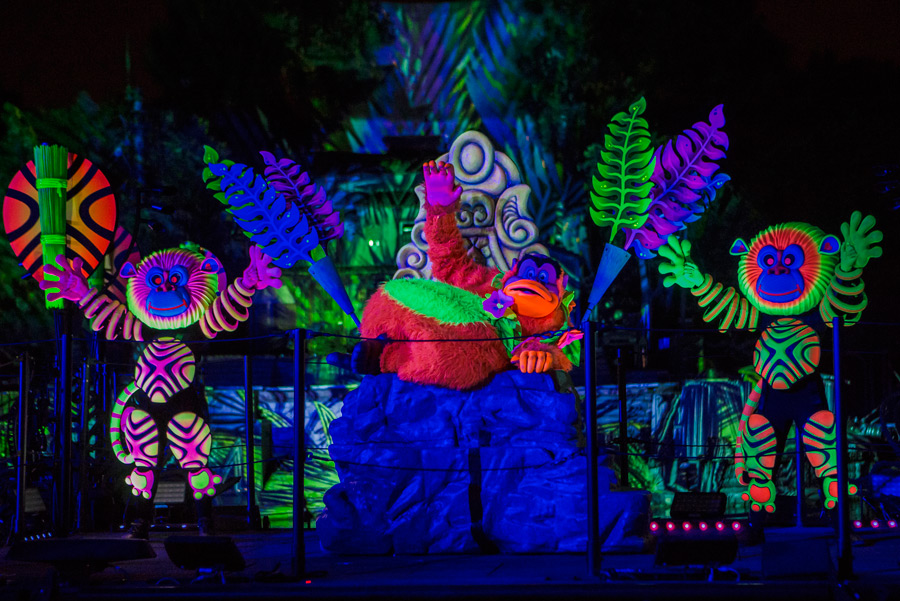
First of all, the show has been accentuated from beginning to end with Imagineering’s favorite tool of the 21st century: projection mapping. In this case, projection is used less to adorn the existing structures of Tom Sawyer Island than to further disguise them. More often than not, the projections are dreamlike and impressionistic; vivid, saturated, and abstract, adding beautifully to the show’s otherworldly nature and creating a depth that the original, in retrospect, lacked. They’re able to shift and reform in the periphery, continuously adding to the complex visual setting.
The show’s fountains, too, were gifted an upgrade, gaining the same LED lighting and “dancing” programmable directionality as Disney California Adventure’s World of Color. Given that upgrade, it’s understandable that the fountains make more appearances, though perhaps not to any greater effect than the simpler originals. Though water screens ceased being the show’s must-see feature decades ago, they’re used to tremendous effect with crisp, re-animated imagery.
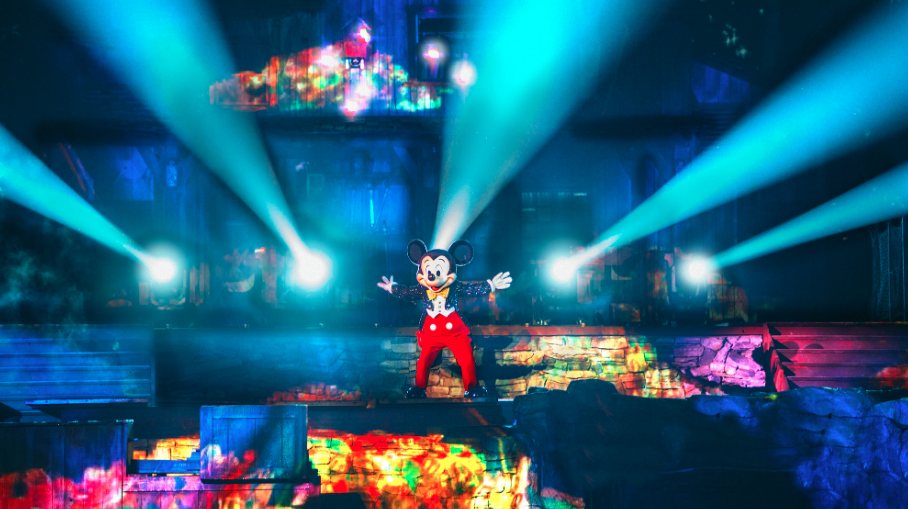
One of the most interesting and subtle changes to debut in 2017, though, was a compelling and easy-to-miss refocusing on Mickey himself. In a swirling collection of focused (projected) energy, Mickey “appears” on the beat that used to signal the white column of light, but rather than waving triumphantly, he’s almost… confused. In a clever way, it makes sense… This, of course, is the moment Mickey falls asleep. Dazed, he lifts his right hand, noticing that it causes the rotating white spotlights; he repeats it with the left, marveling (“Wow…”) at his seeming control of this space…
Gaining a little confidence, he thrusts his arms out as the music crescendoes for the first time, causing an array of new white spotlights to burst to life behind him. When he raises his arms, the lights, too, rise. He points left and right, setting off fireworks and then gasping as he looks at his hands, now fully understanding his power. Then, as projected magic gathers around him in a newly-added musical embellishment, Mickey pulls off one of the coolest additions to the show: he reaches right and pulls a tower of spotlights toward himself, then does the same with a tower on the left, segueing into his opening act with the fountains. In other words, with just ten extra seconds on stage, Mickey is able to sweetly come to understand the powers of his dream world one element at a time.
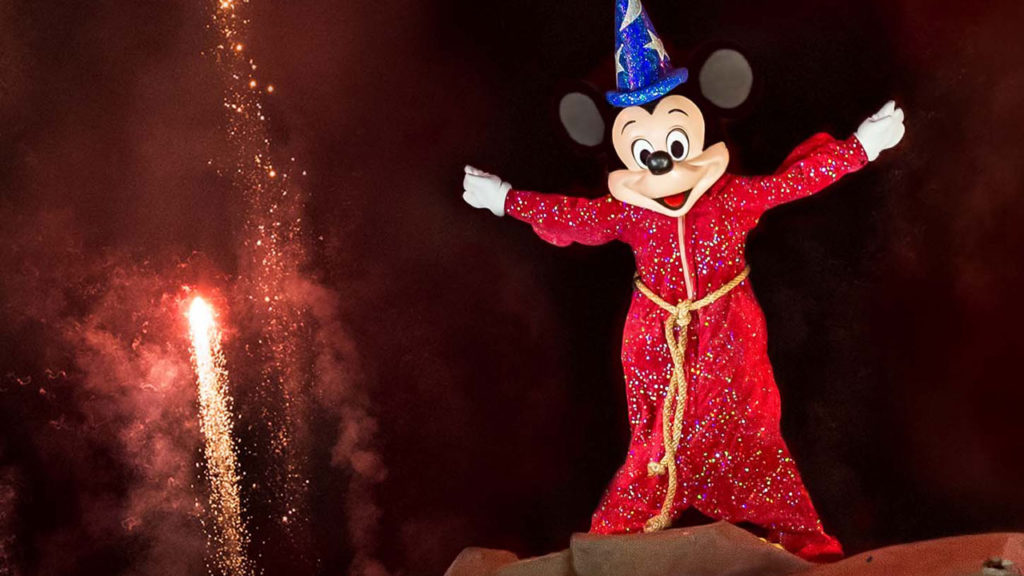
Then, Mickey himself remains the star. Rather than a mere “clip show” of loosely-connected animated vignettes, the show now literally follows Mickey through the vivid layers of his dream. He appears in each scene either on-screen or in-person, diving deeper into each world. And of course, given a 21st century portfolio, those worlds had some updates…
Imagination rewritten
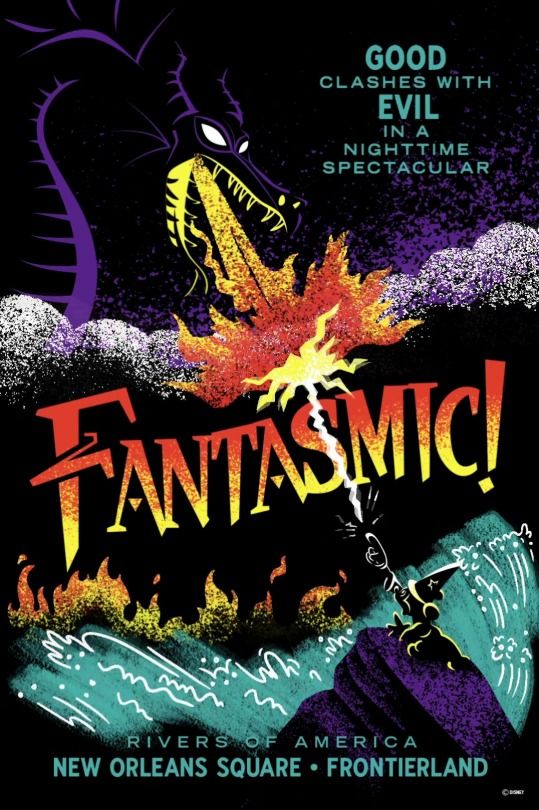
What follows, of course, is a show with plenty of subtle changes and plenty of very noteworthy ones. Whereas Disney World’s Fantasmic has always fallen relatively flat compared to the Californian original due to its focus on modern films, its lack of updates (it still has the puppet Dragon!) and its relative over-reliance on screens, the “updating” of Disneyland’s is more successful, if not more controversial:
- The Jungle Book intro is joined by a Lion King segment (though pulled off much more effectively than Florida’s outright replacing of the former with the latter);
- The “Pink Elephants” sequence (excised in Florida) remains, but now segues into Aladdin rather than Pinocchio (providing the show the requisite “Friend Like Me” segment no Disney Parks nighttime show post-1992 can go without);
- Mickey himself is threaded through each sequence, “swimming” on screen to Atlantica for a Little Mermaid-to-Finding-Nemo-to-Pinocchio transition, melding to the classic Monstro attack;
- In the only unanimous downgrade, the Columbia’s use as a Peter Pan scene is replaced by its use in a non sequitur Pirates of the Caribbean sequence that has none of Pan‘s Technicolor warmth or animated charm and instead has some terrible voice-acting;
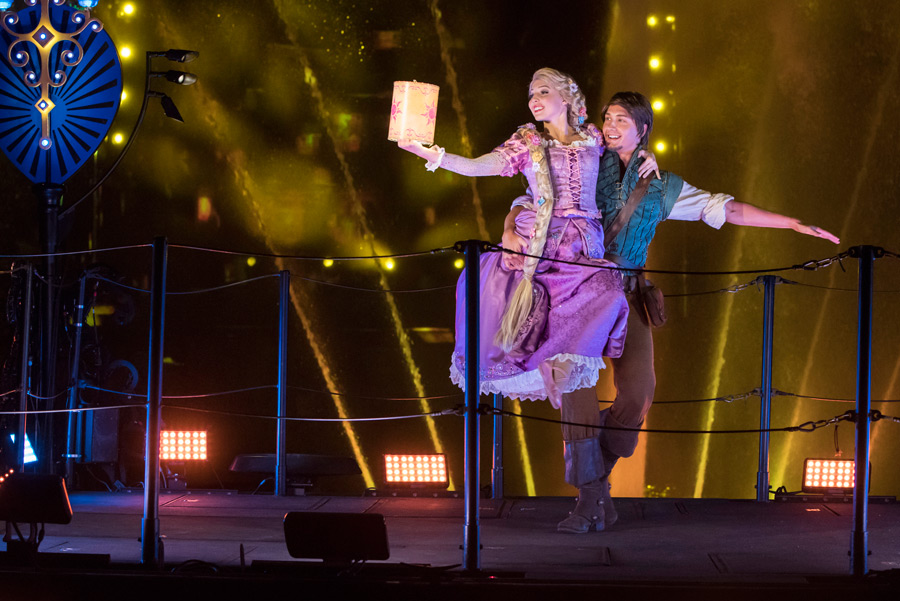
- Singing “A Whole New World” and “I See The Light” respectively, Aladdin and Jasmine (on a Flying Carpet on-stage) and Rapunzel and Flynn Rider (replacing Snow White and Prince Charming on a barge) join the Princess sequence;
- Rather than the Evil Queen calling upon the Magic Mirror and flying into a rage at the Princess’ beauty, here Mickey himself unleashes the Villains by accepting the Mirror’s challenge to dive deeper into the dream world;
- The Dragon can (strangely) be seen rising from the pit rather than staying dark until fully in place;
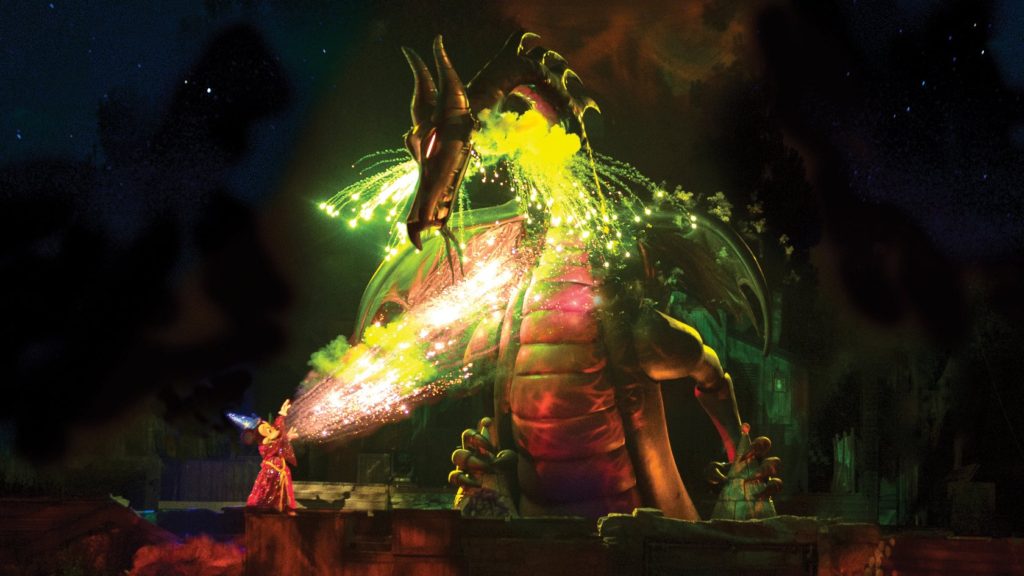
- Whereas he used to defeat the dragon in his “Brave Little Tailor” outfit with a magical sword, now Mickey battles Maleficent as the Sorcerer’s Apprentice, releasing golden sparks from his own hands;
- The dragon releases a second burst of fire directly into the sky as it dies;
- The finale’s lights and pyrotechnics have been re-orchestrated, including – at the close – Mickey again “pulling” the two spotlight towers toward himself just as he does during the introduction
Enjoy a look at the “new” Fantasmic here:
Frankly, the “new” Fantasmic has been met with some mixed reception. Technologically, it’s easy to see how the show may be “overstuffed,” with layered projections and whipping fountains adding to the show’s visual clutter, playing the show’s full hand long before the finale where it should shine. Narratively, the wedging-in of newer Disney and Pixar films likewise create a frantic pace. Mismatched IPs like Pirates of the Caribbean make little sense in a show meant to showcase animated worlds.
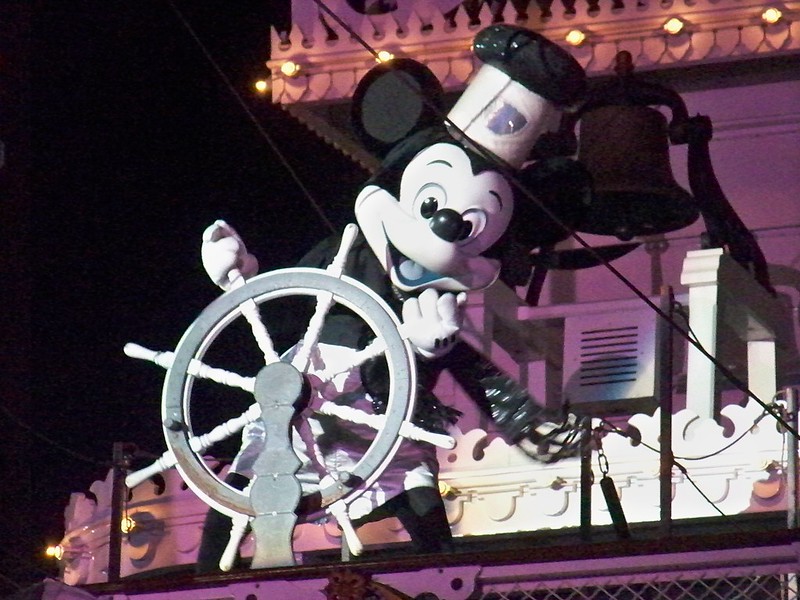
But to our thinking, most of the show’s reimagining was done spectacularly well. Refreshed and rerecorded audio, subtle story changes, and an infusion of fresh IPs (miraculously without overplayed ones like Frozen or Toy Story) have given Fantasmic a much-needed reboot that’ll ensure this show continues to define Disney nighttime spectaculars for decades to come.
A Magical Mix
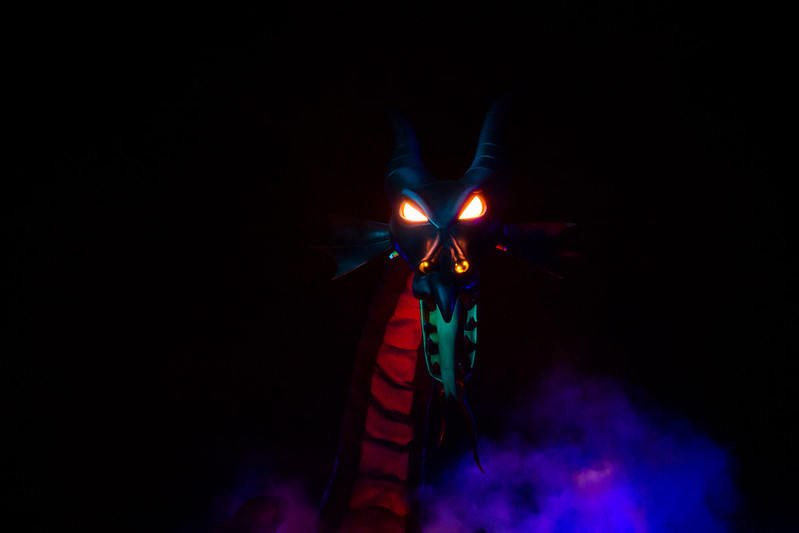
There’s nothing on Earth quite like Disneyland’s Fantasmic. Just imagine: somehow, something has elevated an explosive special effects show fit for the Las Vegas Strip into a timeless Imagineering classic. Since 1992, this epic after-dark journey into Mickey’s imagination has been a fantastic fever dream of light, color, fire, water, music, and magic.
Fantasmic has what every other nighttime spectacular since has tried to recreate: a “Magical Mix.” It would be impossible to recreate the conditions from which Fantasmic was born. From Walt Disney’s River and Joe Fowler’s ships to Don Dorsey and Adam Bezark’s early entertainment concepts; from its magnificent music by Bruce Healey to its imaginative basis from Barnette Ricci… Fantasmic’s Screens, Setting, Score, and Story are truly iconic.

The way it unfolds from nothing; how it transforms Disneyland’s Rivers of America before your very eyes, changing the park you know into something otherworldly; how in a blink, it all disappears as if you’ve imagined the whole thing… That’s why Fantasmic is the perfect attraction for our Modern Marvels series and as the next entry in our Night Magic mini-series. We hope you’ve enjoyed this in-depth history, and until next time, keep dreaming…

Thank you so much for reading. Now, it’s your turn to join the story. If you enjoy spending time falling down the “rabbit hole” of Park Lore’s in-depth, ad-free, member-supported stories, consider becoming a Member for as little as $2 / month.
Members can unlock rare concept art in every tale, reveal attraction audio streams in select stories, gain access to over a hundred exclusive articles in our quick-read Extra Features and in-depth Special Features collections, gain exclusive podcast extras, and receive an annual member card and merch in the mail! (Plus, y’know, supporting research-based, ad-free, clickbait-free, in-depth theme park writing!)


